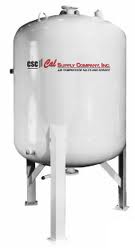Difference between revisions of "Deliquescent Dryers"
| Line 5: | Line 5: | ||
* Please start editing this page after the /noinclude | * Please start editing this page after the /noinclude | ||
* -------------------------------------------------></noinclude> | * -------------------------------------------------></noinclude> | ||
[[File: | [[File:Deliquescent_Dryers.jpg|thumb|200px|right|Deliquescent Dryers]] | ||
A deliquescent dryer typically consists of a pressure vessel filled with a hygroscopic media that absorbs water vapor. The media gradually dissolves—or deliquesces—to form a solution at the base of the pressure vessel. The liquid must be regularly drained from the vessel and new media must be added. The media is usually in tablet or briquette form. Deliquescent dryers have no moving parts and don't require electrical power for operation. Common applications therefore often involve remote, hazardous, or mobile worksites. Deliquescent dryers are used for removing water vapor from compressed air, natural gas, and waste gases such as landfill gas and digester gas. The performance of a deliquescent dryer, as measured by outlet dew point, is highly dependent on the temperature of the air or gas being processed, with cooler temperatures resulting in better performance. | A deliquescent dryer typically consists of a pressure vessel filled with a hygroscopic media that absorbs water vapor. The media gradually dissolves—or deliquesces—to form a solution at the base of the pressure vessel. The liquid must be regularly drained from the vessel and new media must be added. The media is usually in tablet or briquette form. Deliquescent dryers have no moving parts and don't require electrical power for operation. Common applications therefore often involve remote, hazardous, or mobile worksites. Deliquescent dryers are used for removing water vapor from compressed air, natural gas, and waste gases such as landfill gas and digester gas. The performance of a deliquescent dryer, as measured by outlet dew point, is highly dependent on the temperature of the air or gas being processed, with cooler temperatures resulting in better performance. | ||
The '''Deliquescent Dryers''' utilize an absorptive type chemical (desiccant) to provide a 20ºF to 25ºF (-6.6°C to -3.8°C) dew point suppression below the compressed air temperature entering the dryer. The moisture in the compressed air reacts with the absorptive material to produce a liquid effluent that is drained out of the dryer. This effluent must be disposed of in accordance with local regulations. | |||
The '''Deliquescent Dryers''' utilize an absorptive type chemical (desiccant) to provide a 20ºF to 25ºF (-6.6°C to -3.8°C) dew point suppression below the compressed air temperature entering the dryer. The moisture in the compressed air reacts with the absorptive material to produce a liquid effluent that is drained out of the dryer. This effluent must be disposed of in accordance with local regulations. | |||
Deliquescent dryers are typically used in applications such as, sandblasting and logging. They are not recommended for industrial applications since the dried compressed air exiting the dryer may contain small amounts of the effluent that may be corrosive to downstream equipment. | Deliquescent dryers are typically used in applications such as, sandblasting and logging. They are not recommended for industrial applications since the dried compressed air exiting the dryer may contain small amounts of the effluent that may be corrosive to downstream equipment. | ||
==Video== | ==Video== | ||
<youtube>OJQ71Vmh2xs</youtube> | <youtube>OJQ71Vmh2xs</youtube> | ||
Revision as of 09:08, 30 July 2012
A deliquescent dryer typically consists of a pressure vessel filled with a hygroscopic media that absorbs water vapor. The media gradually dissolves—or deliquesces—to form a solution at the base of the pressure vessel. The liquid must be regularly drained from the vessel and new media must be added. The media is usually in tablet or briquette form. Deliquescent dryers have no moving parts and don't require electrical power for operation. Common applications therefore often involve remote, hazardous, or mobile worksites. Deliquescent dryers are used for removing water vapor from compressed air, natural gas, and waste gases such as landfill gas and digester gas. The performance of a deliquescent dryer, as measured by outlet dew point, is highly dependent on the temperature of the air or gas being processed, with cooler temperatures resulting in better performance.
The Deliquescent Dryers utilize an absorptive type chemical (desiccant) to provide a 20ºF to 25ºF (-6.6°C to -3.8°C) dew point suppression below the compressed air temperature entering the dryer. The moisture in the compressed air reacts with the absorptive material to produce a liquid effluent that is drained out of the dryer. This effluent must be disposed of in accordance with local regulations.
Deliquescent dryers are typically used in applications such as, sandblasting and logging. They are not recommended for industrial applications since the dried compressed air exiting the dryer may contain small amounts of the effluent that may be corrosive to downstream equipment.
Video
